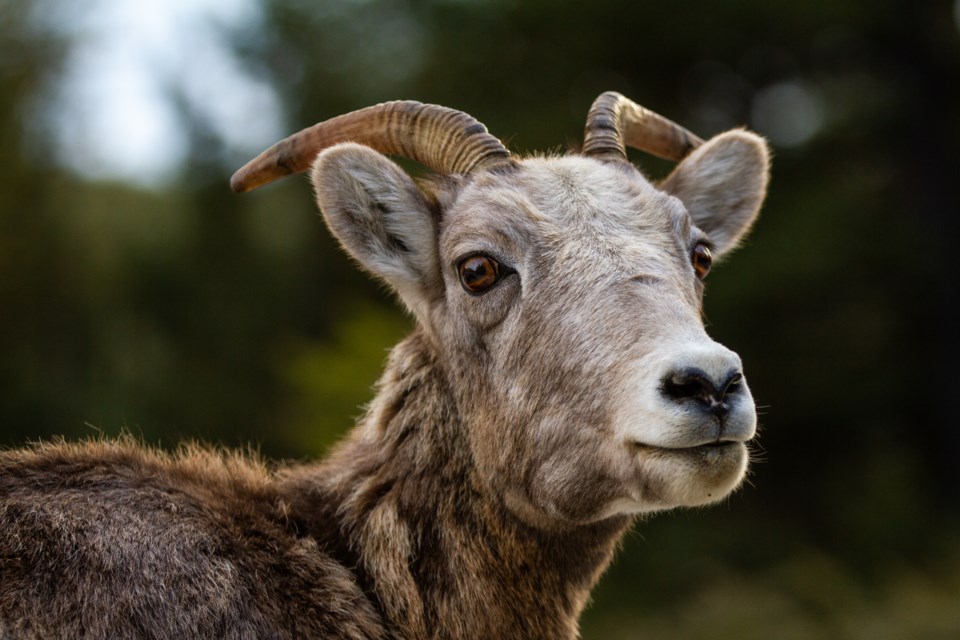BANFF – A new study has been launched to get a better handle on the health and population status of bighorn sheep and mountain goats in Banff National Park.
Last month, 17 sheep were fitted with GPS collars – seven in the Mount Norquay area and 10 in and around the bison reintroduction zone on the eastern slopes of the park – as well as six mountain goats at Mount Bourgeau west of Banff.
Parks Canada officials say the radio-collaring based studies aim to more accurately determine birth rates, survival, reproductive rates, as well get a better idea on bighorn sheep habitat use and movement patterns, which are directly linked to sheep health and conservation.
“We know very little about our bighorn sheep and mountain goat populations in Banff National Park,” said Parks Canada ecologist Jesse Whittington.
“We did a little bit of research over 30 years ago on some bighorn sheep and since then we’ve done very little.”
For bighorn sheep, the project for both front country and backcountry herds is the next step in an ongoing bighorn sheep health assessment program following discovery of a new herpes-type virus in bighorn sheep.
In June 2015, an emaciated ewe with extensive hair loss and skin crusting was seen on the access road to Sunshine Village.
The animal was put down for humane reasons, and testing showed it had numerous and severe health issues, including immune system dysfunction, parasites and multiple abscesses.
The testing led to the discovery of a new malignant catarrhal fever (MCF), a herpes-like virus in bighorn sheep.
“That animal had a rare type of virus that we didn’t really know occurred in Banff,” said Whittington. “It was an eye-opener for us.”
During follow up monitoring in the Sunshine area, other bighorn sheep showed similar but less extensive skin lesions, hair loss, and abnormal molt. There was also anecdotal evidence suggesting fewer lambs being born in the Sunshine Village herd range.
Although less severe and in fewer individuals, similar lesions were also seen on bighorn sheep from the Norquay, Highway 1A, and Lake Minnewanka herd ranges.
Animals in poor body condition with chronic diarrhea were recorded in the Minnewanka herd range.
Whittington said a wildlife health and disease specialist noticed some of the bighorn sheep herds in the Bow Valley “have been in very poor health.”
“Some of the sheep around Minnewanka, Norquay, the Sunshine area have appeared ratty and emaciated – skinny, with their bones protruding,” said Whittington.
“We’re not overly concerned that that virus will wipe out the sheep population, but bighorn sheep in general are susceptible to a lot of parasites and diseases and so we just want a better handle on the health status of this population.”
Whittington said he hopes the collaring study will give better insight into how the animals are faring throughout the park.
“Are they nutritionally stressed? Where’s the best habitat? Can they get there? How connected are the populations and how far and wide are these animals ranging,” he said.
“If we can get a better handle on what’s driving these populations, it will help us manage them and make sure we have them in the future.”
The collaring study also aims to gather information to better understand how populations of mountain goats in Banff are doing.
Anecdotally, Whittington said mountain goat populations may have declined, but noted there is no hard evidence to support that entirely.
“They were more common in some places like the Cascade, Ishbel ranges than they are now, but they could have also just moved to another mountain range or changed where they’re spending time, so this will help us learn this,” he said.
Whittington said very little is known about the mountain goats here because they live in such rugged terrain, making it difficult to spot all animals in a herd even during helicopter surveys.
“We felt like with a lot of human activity occurring, especially Bourgeau, it seems a really important area of goats, but we really don’t know,” he said.
“How frequently do they come down to the valley bottoms? Do they travel to some other mountain ranges? There’s just a lot of questions about these animals.”
Parks Canada also has questions on how human activity may affect wild goats and sheep.
“We really don’t have a sense if they’re avoiding areas with people or if that affects the sites they select for having their babies,” he said.




